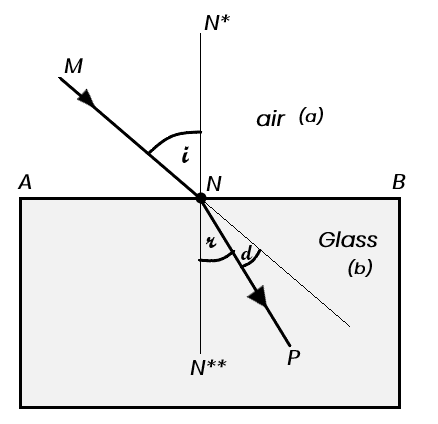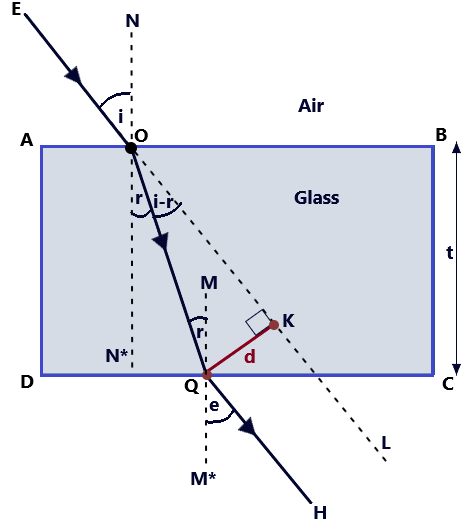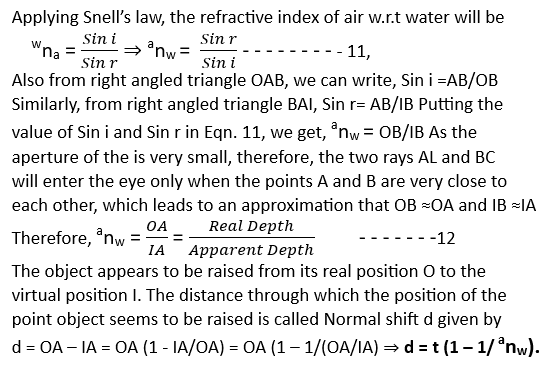refraction of light-12
It is the deviation of the light ray from its original path when it goes from one medium to another medium of different densities.
It is evident from the experimental observations that the light ray, in a homogeneous medium, travels along a straight path. But when this ray of light travels from one transparent medium to another, of different densities, it bends while crossing the surface, separating the two media. Therefore, the phenomenon of change in the path of light as it goes from one medium to another is called Refraction of light-12
When the light ray passes from an optically rarer medium to a denser medium, it bends toward the normal and when it travels from a denser medium to a rarer medium, it bends away from the normal as shown in fig. 01 where the surface AB separates two transparent media, (say (a) air, and (b) glass).
The light ray, traveling along MN in the air which is an optically rare medium, enters the glass which is an optically denser medium at point N, then it will bend from its straight path MN and goes along NP in the glass medium. (refraction of light-12)
The angle between the incident ray and the normal to the surface AB separating the two media at point N is called the angle of incidence i and the angle between the refracted ray and the normal to the surface AB separating the two media at point N is called the angle of refraction r. (refraction of light-12)

Laws of refraction of light-12
When the phenomenon of refraction takes place, it has to be governed by certain laws, called laws of refraction
- First Law of refraction: The incident ray, the normal to the refracting surface at the point of incidence, and the refracted ray, meet at the same point and all lie in the same plane.
- Second Law of refraction: The ratio of the sine of the angle of the incidence to the sine of the angle of refraction is always constant for the two-given media. Th
The constant is denoted by anb and is called the refractive index of medium b, in which the reflected ray travels with respect to medium a, in which the incident ray of light travels.

The relative refractive index of medium b w.r.t medium a (anb) depends upon the nature of the pair of the two media (air-glass, glass-air, water-glass, glass-water, air-water, water-air, etc. is different for each pair given here) and the wavelength of the light ray. The color of the light ray is characteristic to the wavelength, so the relative refractive index of a medium is different for different colours. As per Cauchy’s relation, shorter the wavelength larger the refractive index and vice-versa. It is due to this reason that the refractive index of a medium is greater for violet light being of shorter wavelength than that for red color being of longer wavelength.
The absolute refractive index of a medium may also be defined as the ratio of the velocity of light in air/ vacuum to the velocity of light in that medium. Thus, n = velocity of light in vacuum / velocity of light in the medium = c/v. As c > v, hence n > 1. We therefore, conclude that a medium having larger value of refractive index is said to be a denser medium and that having smaller value of refractive index is said to be a rarer medium.
Principle of reversibility of light-refraction of light-12
Principle of reversibility of light states that if light after suffering any number of reflections and refractions has its final path reversed and it retraces it while made to travel back along the same path in the opposite direction by putting a mirror in its path.


The principle of reversibility of light provides us an important inference that the refractive index of the medium b with respect to medium a is reciprocal to the refractive index of the medium a with respect to medium b.
Lateral shift in refraction of light-12
The perpendicular distance between the incident ray and the emergent ray is called lateral shift, when the light is incident obliquely on a parallel sided reflecting slab.

Let us consider a glass slab ABCD bounded by parallel faces AB and CD as shown in fig. 2.03. A ray of light EO traveling in the air gets incident on the face AB at an angle of incidence i. On refraction into the glass, a denser medium bends towards the normal NON* dash travel and travels along the path OQ inside the glass, such that r is the angle of reflection.
As the two faces of the glass slab AB and CD are parallel, the refracted ray OQ strikes the surface CD at the angle of incidence r. On refraction into the air, the ray of light bends away from the normal MQM* and travels along the path QK in the air, such that the angle of the refraction is i. The emergent ray QH is parallel to the incident ray EOL. From point Q draw QK perpendicular to the initial path EOL, then QK=d is called the lateral shift, produced by the glass slab in the path of the light.

From Eqn. 07, the conclusion can be drawn that the lateral shift produced by the glass slab increases with
- The increase in the thickness of the glass slab.
- The increase in the angle of incidence of the light ray on the first surface of the glass slab.
- The increase in the refractive index of the material of the slab
Multiple refraction of light-12
Let us consider a compound plate of two media water (w) and glass (g) bounded by the two parallel faces AB and EF and placed in the air as shown in Fig. Let us further suppose that a light ray is making an incidence at point O making an angle of incidence i, undergoes multiple refractions at points O* and O** and finally emerges out as O**K and goes out into the air. As per the ray diagram, the relative refractive index of water w.r.t air medium, the relative refractive index of glass w.r.t water medium, and the relative refractive index of air w.r.t glass medium, will be given as



Normal shift in refraction of light-12
As an outcome of refraction, the depth of an object lying inside an optically denser medium appears to be less than its real depth.
Suppose that the surface XY separates medium a (air) and medium b (water or any other transparent denser medium). Let O be a point object inside the liquid at its bottom as shown in the figure. A light ray from the point object O is incident along the normal (OA) to the surface of the liquid, will undergo refraction without any deviation from its actual path (along A L).
Another ray of light OB on refraction into air bends away from the normal NBN* and so will travels along BC. The two refracted rays appear to come from the point I. Thus, the virtual image of the point object O is formed at point I, therefore the object, though is lying at a depth AO appears to be at depth A I. Accordingly, AO is called the real depth and A I, the apparent depth of the object O, while IO is called Normal Shift.


KEY POINT: The normal shift (d) in the position of the object placed in a denser medium depends upon the value of its refractive index of the medium. Higher the value of refractive index, greater is the apparent shift of the medium
From this expression, it is clear that, the normal shift in the position of the body depends upon the real path of the object (thickness of the medium) and the refractive index of the medium
